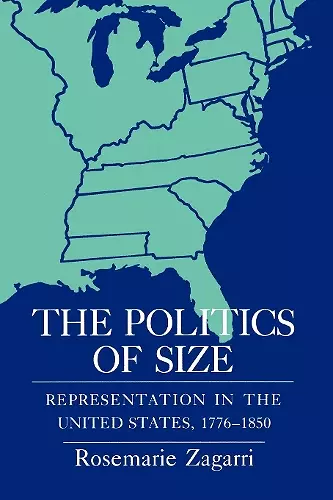The Politics of Size
Representation in the United States, 1776–1850
Format:Paperback
Publisher:Cornell University Press
Published:29th Apr '10
Currently unavailable, and unfortunately no date known when it will be back
This paperback is available in another edition too:
- Hardback£50.00(9780801420191)

After the Revolution, Americans faced the challenge of expanding representative government throughout an extensive territory. The complex process of adapting republicanism to a vast area generated many conflicts over representation in both states and the nation—conflicts that produced a division between the large states and the small states. Using concepts of historical geography, Rosemarie Zagarri examines how Americans' notions about space influenced the writing of the U.S. Constitution and the shaping of the nation's political institutions.
In The Politics of Size, Zagarri offers a bold explanation of political alignments in the early republic. The split between large and small states emerged, she asserts, not at the Constitutional Convention of 1787 but in the years before, during debates over the relocation of state capitals and the reapportionment of state legislatures. The local conflicts culminated in the fierce struggle between the two factions at the federal convention. Far from ending there, the division persisted well into the nineteenth century, resurfacing when Congress discussed such controversial issues as congressional redistricting, the selection of presidential electors, and the reapportionment of the House of Representatives. Only in 1850 did the conflict based on state size merge with, and become subsumed by, the growing controversy between North and South.
Historians have been puzzled for two hundred years about the causes of the famous large-versus-small-state controversy that erupted during that long, hot summer in Philadelphia and found its solution in the Great Compromise that made the Constitution possible.... Rosemarie Zagarri's book solves the mystery. She argues quite cogently that the politicians and citizens of 'the small' states retained an older system of corporate or community representation... while many in the large states with rapidly growing populations had concluded that a new system of representation, based on population instead of units, was a necessary response to change.
* Journal of American History *Zagarri's book is as brilliant as it is bright. Drawing her inspiration from the principles and practice of human geography, she shows... that the demographic theory of representation was ideal for expansionism, though it ironically provided the environment in which sectionalism could arise in its ugly, antebellum form.
* Choice *Zagarri's work makes a useful contribution to the literature on representation, illuminating the role that spatial thinking played as a bridge between inherited conceptions of actual and virtual representation and more modern ideas.
* American Journal of Legal HistoISBN: 9780801476396
Dimensions: 229mm x 152mm x 14mm
Weight: 454g
180 pages